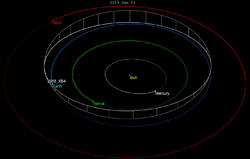Astronomy:2018 XB4
 Orbit of 2018 XB4 with 15-day motion shown | |
| Discovery [1][2] | |
|---|---|
| Discovered by | Pan-STARRS |
| Discovery site | Haleakala Obs. |
| Discovery date | 13 December 2018 (first observed only) |
| Designations | |
| 2018 XB4 | |
| Minor planet category | Apollo [2][3] · NEO |
| Orbital characteristics [3] | |
| Epoch 27 April 2019 (JD 2458600.5) | |
| Uncertainty parameter 5 [3] · 6 [2] | |
| Observation arc | 42 days |
| |{{{apsis}}}|helion}} | 1.2848 AU |
| |{{{apsis}}}|helion}} | 0.8577 AU |
| 1.0712 AU | |
| Eccentricity | 0.1993 |
| Orbital period | 1.11 yr (405 d) |
| Mean anomaly | 35.965° |
| Mean motion | 0° 53m 20.4s / day |
| Inclination | 8.7263° |
| Longitude of ascending node | 92.063° |
| 92.282° | |
| Earth MOID | 0.0023 AU (0.9 LD) |
| Jupiter MOID | 3.68 AU |
| Physical characteristics | |
| Mean diameter | 53 m[4] |
| Absolute magnitude (H) | 24.0[2][3] |
2018 XB4 (also written 2018 XB4) is an Apollo near-Earth asteroid roughly 53 meters (170 feet) in diameter. It was discovered on 13 December 2018 when the asteroid was about 0.125 AU (18,700,000 km; 11,600,000 mi) from Earth and had a solar elongation of 146°. It passed closest approach to Earth on 1 January 2019.[3] Of the asteroids discovered in 2018, it had the highest Palermo scale rating at –3.6. In mid-2019 it was recovered which extended the observation arc to 177 days and was removed from the Sentry Risk Table on 12 June 2019. It is now known that on 22 June 2092 the asteroid will pass about 0.033±0.015 astronomical unit|AU from Earth.[3]
With a 42-day observation arc, the Sentry Risk Table showed an estimated 1 in 6200 chance of the asteroid impacting Earth on 22 June 2092.[4] The nominal JPL Horizons 22 June 2092 Earth distance was 0.17 AU (25,000,000 km; 16,000,000 mi) with a 3-sigma uncertainty of ±320 million kilometers. A Monte Carlo simulation using Solex 12 with 1000 clones of the asteroid showed that by 2092 the uncertainty region for 2018 XB4 stretched around the entire orbit.[5] NEODyS listed the nominal 22 June 2092 Earth distance as 0.009 AU (1,300,000 km; 840,000 mi).[6]
References
- ↑ "MPEC 2018-X119: 2018 XB4". IAU Minor Planet Center. 15 December 2018. https://www.minorplanetcenter.net/mpec/K18/K18XB9.html. Retrieved 19 February 2019. (K18X04B)
- ↑ 2.0 2.1 2.2 2.3 "2018 XB4". Minor Planet Center. https://www.minorplanetcenter.net/db_search/show_object?object_id=2018+XB4. Retrieved 26 February 2019.
- ↑ 3.0 3.1 3.2 3.3 3.4 3.5 "JPL Small-Body Database Browser: (2018 XB4)". Jet Propulsion Laboratory. http://ssd.jpl.nasa.gov/sbdb.cgi?sstr=2018XB4;cad=1. Retrieved 19 February 2019.
- ↑ 4.0 4.1 "Earth Impact Risk Summary: 2018 XB4". NASA/JPL Near-Earth Object Program Office. https://cneos.jpl.nasa.gov/sentry/details.html#?des=2018%20XB4. Retrieved 20 February 2019.
- ↑ Solex clones (Peter Thomas)
- ↑ "2018XB4 Ephemerides for 22 June 2092". NEODyS (Near Earth Objects – Dynamic Site). https://newton.spacedys.com/neodys/index.php?pc=1.1.3.1&n=2018XB4&oc=500&y0=2092&m0=6&d0=22&h0=0&mi0=0&y1=2092&m1=6&d1=23&h1=0&mi1=0&ti=1.0&tiu=hours. Retrieved 20 February 2019.
External links
- 2018 XB4 at NeoDyS-2, Near Earth Objects—Dynamic Site
- Ephemeris · Obs prediction · Orbital info · MOID · Proper elements · Obs info · Close · Physical info · NEOCC
- 2018 XB4 at the JPL Small-Body Database
 |



